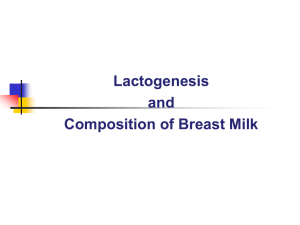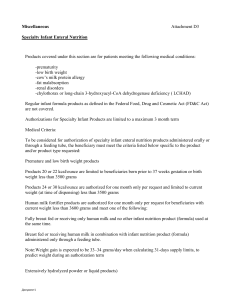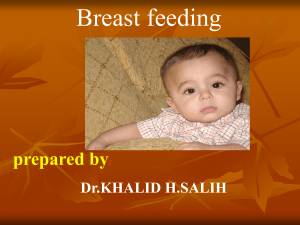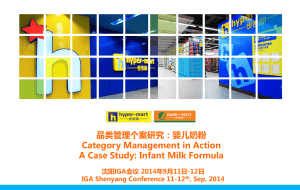Are atypical antipsychotics safe during breast feeding?
advertisement
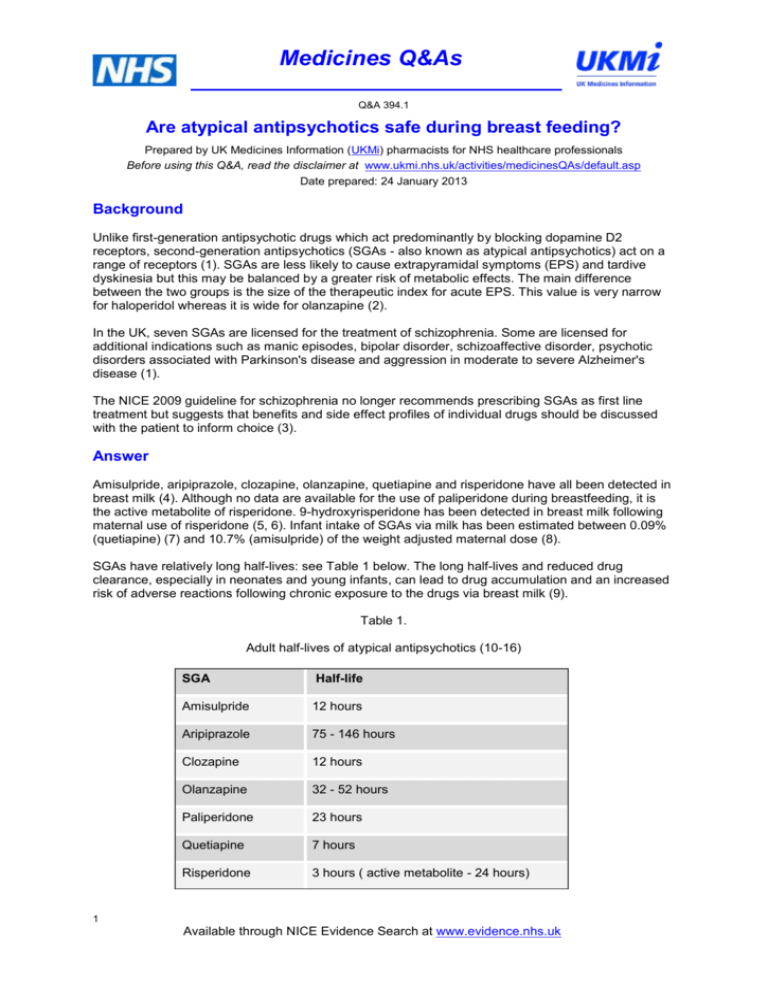
Medicines Q&As Q&A 394.1 Are atypical antipsychotics safe during breast feeding? Prepared by UK Medicines Information (UKMi) pharmacists for NHS healthcare professionals Before using this Q&A, read the disclaimer at www.ukmi.nhs.uk/activities/medicinesQAs/default.asp Date prepared: 24 January 2013 Background Unlike first-generation antipsychotic drugs which act predominantly by blocking dopamine D2 receptors, second-generation antipsychotics (SGAs - also known as atypical antipsychotics) act on a range of receptors (1). SGAs are less likely to cause extrapyramidal symptoms (EPS) and tardive dyskinesia but this may be balanced by a greater risk of metabolic effects. The main difference between the two groups is the size of the therapeutic index for acute EPS. This value is very narrow for haloperidol whereas it is wide for olanzapine (2). In the UK, seven SGAs are licensed for the treatment of schizophrenia. Some are licensed for additional indications such as manic episodes, bipolar disorder, schizoaffective disorder, psychotic disorders associated with Parkinson's disease and aggression in moderate to severe Alzheimer's disease (1). The NICE 2009 guideline for schizophrenia no longer recommends prescribing SGAs as first line treatment but suggests that benefits and side effect profiles of individual drugs should be discussed with the patient to inform choice (3). Answer Amisulpride, aripiprazole, clozapine, olanzapine, quetiapine and risperidone have all been detected in breast milk (4). Although no data are available for the use of paliperidone during breastfeeding, it is the active metabolite of risperidone. 9-hydroxyrisperidone has been detected in breast milk following maternal use of risperidone (5, 6). Infant intake of SGAs via milk has been estimated between 0.09% (quetiapine) (7) and 10.7% (amisulpride) of the weight adjusted maternal dose (8). SGAs have relatively long half-lives: see Table 1 below. The long half-lives and reduced drug clearance, especially in neonates and young infants, can lead to drug accumulation and an increased risk of adverse reactions following chronic exposure to the drugs via breast milk (9). Table 1. Adult half-lives of atypical antipsychotics (10-16) SGA Half-life Amisulpride 12 hours Aripiprazole 75 - 146 hours Clozapine 12 hours Olanzapine 32 - 52 hours Paliperidone 23 hours Quetiapine 7 hours Risperidone 3 hours ( active metabolite - 24 hours) 1 Available through NICE Evidence Search at www.evidence.nhs.uk Medicines Q&As Adverse effects have been reported in breastfed infants exposed to clozapine (17) and olanzapine (18, 19). Infant sedation has been described when breastfeeding mothers were receiving co-therapy of SGAs with benzodiazepines (20,21). Since dopamine inhibits prolactin release, all antipsychotics acting as dopamine antagonists can cause measurable changes in serum prolactin but in some cases, levels do not exceed the normal range. The increase in serum prolactin is probably dose-related (2). Prolactin levels in mothers with established lactation may not affect the ability to breastfeed (22).A prolonged and elevated prolactin level above baseline non-lactational levels is required for sustained milk production. The volume of milk secreted is not directly related to the plasma prolactin level. (23). One possible case of failure to establish lactation has been reported in a woman taking aripiprazole (24). Neonates exposed to antipsychotics near term may exhibit withdrawal symptoms including agitation, hypertonia, tremor, somnolence, respiratory distress or feeding disorders (10). Amisulpride Data on the use of amisulpride during lactation are limited to two mother-infant pairs (8,25,). Infant intake via breast milk has been estimated as 183 mcg/kg daily or 6.1% of the maternal weightadjusted dosage after a maternal daily dose of 200 mg (25) and 534 mcg/kg daily or 10.7% of the maternal weight-adjusted dosage after a maternal daily dose of 400 mg (8). Infant serum amisulpride concentration 3.1 hours after the mother's daily dose of 200 mg was 4 mcg/L or 3.9% of the maternal serum concentration (25).No adverse effects in breastfed infants have been reported to date. Aripiprazole Only limited data are available from three mother-infant pairs (26, 27, 28).After maternal daily doses of 15 - 18 mg daily, milk levels for aripiprazole of 13 - 14 mcg/L (26) and 38.7 mcg/L (28) were recorded. Milk:plasma ratios have been estimated between 0.04 (27) and 0.2 (26). A case report noted that milk drug levels taken 30 minutes before the maternal dose and at 4 and 10 hours r post dose were undetectable ( < 10 mcg/L) 27 days post-delivery. The authors estimated that a fully breastfed infant would receive less than 0.7% of the maternal weight-adjusted dosage (27). There are anecdotal reports of somnolence breastfed infants (29). Clozapine Quantitative data on the passage of clozapine into breast milk is based on a single case report (30). A milk clozapine level of 63.5 mcg/L was noted one day postpartum. At 3 days postpartum her dose was increased from 50mg to 100 mg daily, and at 7 days postpartum clozapine in milk was 115.6 mcg/L with a corresponding maternal plasma level of 41.4ng/ml. Limited data suggest that clozapine may accumulate in breast milk. The infant did not breastfeed. In a group of 4 breastfed infants exposed to clozapine via breast milk, one infant experienced drowsiness and one infant experienced agranulocytosis possibly caused by clozapine (17). One female infant exposed to clozapine throughout pregnancy and lactation (up to 1 year) had a delay in speech development which was not normal until 5 years of age. The authors stated that this may have been due to exposure to the drug in lactation or pregnancy or may have been unrelated to maternal therapy (31). Women taking clozapine should not breastfeed (32). Olanzapine Limited information indicates that maternal doses of olanzapine up to 20 mg daily produce low levels in milk and undetectable levels in the serum of breastfed infants. Median infant intake of olanzapine has been estimated at 1.02% (33) in one study and 4% of the weight adjusted maternal dose in a single case report (34). A median peak milk level of 16 mcg/L occurred 5.2 hours (range 0.7 to 13.2 hours) after the dose in one study (33). A median milk:plasma ratio of 0.38 was noted in the same study (33).Olanzapine has been detected in the serum of breastfed infants whose mothers were taking olanzapine in some studies (35, 36). Isolated reports of adverse effects in breastfed infants exposed to olanzapine via milk have been reported (37). Somnolence, diarrhoea and nappy rash were reported in in 1 infant and lethargy, poor sucking and shaking in a second (38). 2 Available through NICE Evidence Search at www.evidence.nhs.uk Medicines Q&As Paliperidone Although no data are available for the use of paliperidone during breastfeeding, it is the active metabolite of risperidone. Risperidone data indicate that the concentrations of paliperidone (9hydroxyrisperidone) in breast milk are low, and amounts ingested by the infant are small (see below) (39). Quetiapine Published experience of the use of quetiapine in lactation is limited to 22 mother-infant pairs (40). Peak drug levels in milk have been recorded one hour post dose (7,41).Infant intake via milk has been estimated between 0.09% (7,41) and less than 0.5% (42) of the maternal weight-adjusted dosage. Very few adverse effects have been reported in breastfed infants. One case of infant sedation was noted but was attributed to co-therapy with mirtazapine and a benzodiazepine (20).In a group of six nursing mothers taking quetiapine in doses of 25 to 400 mg daily in addition to an antidepressant (usually paroxetine) for major depression postpartum, infants' development were tested at 9 to 18 months. Measurements were slightly low on the mental and psychomotor development scale in one infant and on the mental development scale in another. All other scores were within normal limits. The authors concluded that the low scores of the 2 infants were probably not caused by the drugs received by the infants in breast milk (43). Risperidone Limited information indicates that maternal risperidone doses of up to 6 mg daily produce low levels in milk (39).Estimated infant intake via milk has been estimated between 2.2 and 4.7% of the weight adjusted dose (5,6,44). No adverse effects have been reported in breast fed infants where the mother was receiving monotherapy with risperidone (39). Sedation was reported in one breastfed infant whose mother was taking risperidone in combination with flurazepam, clonazepam and bupropion (21). Summary Only limited data are available on the use of SGAs during lactation. SGAs with the greatest evidence of safety for mother and infant should be considered first. Mothers receiving therapy with clozapine should not breastfeed. Estimates of infant ingestion of SGAs via breast milk vary between 0.09% and 10.7% of the weight adjusted maternal dose. Adverse reactions in breast fed infants have been reported after exposure to clozapine and olanzapine via breast milk. Sedation has been noted only when the mother was receiving co-therapy with benzodiazepines and some antidepressants. Risks can be minimised by using single daily doses and administering before the infant’s longest sleep period. When necessary (e.g. with high dose therapy) for very young infants feeding frequently, one bottle feed can be substituted to avoid exposure to peak milk levels, where time to peak levels are known. Infants exposed to SGAs via breast milk should be monitored for sedation, poor feeding, behavioural effects, extrapyramidal symptoms and achievement of developmental milestones. Combined use with other sedating agents is best avoided as this increases the risks of drowsiness and poor feeding in the infant. Premature infants should not be exposed to antipsychotic medication via breast milk. 3 Available through NICE Evidence Search at www.evidence.nhs.uk Medicines Q&As Limitations Only limited data are available for the passage of atypical antipsychotics into breast milk. The majority of studies are single case reports or studies in small numbers of breast feeding mothers .Infant serum levels (as a more accurate measure of infant drug exposure) are often lacking. The above outline is provided for general guidance. Many decisions as to the safety of antipsychotic regimens in breastfeeding mothers will need to be taken on a case-by-case basis, particularly if there are unusual circumstances e.g. infant morbidity, requirement for high doses, concurrent medication etc. In these instances, further advice can be sought from the UK Drugs in Lactation Advisory Service provided by the Trent Medicines Information Service or the West Midlands Medicines Information Service. References 1. 2. 3. 4. 5. 6. 7. 8. 9. 10. 11. 12. 13. 14. 15. 16. 17. 18. 19. 20. 21. 22. 23. Rachel S.M.Ryan, Editor. British National Formulary No 64, London: British Medical Association and the Royal Pharmaceutical Society of Great Britain; September 2012.Accessed 24/01/2013 via http://www.bnf.org/bnf/ Taylor D, Paton C,Kapur S. Prescribing Guidelines in Psychiatry. The South London and Maudsley NHS Foundation Trust & Oxleas NHS Foundation Trust 11th Ed. Wiley-Blackwell 2012 National Institute for Health and Clinical Excellence. Clinical Guideline 82. Core interventions in the treatment of schizophrenia in primary and secondary care (update). March 2009. Accessed 24/01/2013 via http://www.nice.org.uk/nicemedia/live/11786/43610/43610.pdf Trent and West Midlands Medicines Information Services. UKDILAS database. Accessed 24/01/2013 Hill RC, McIvor RJ, Wojnar-Horton RE et al. Risperidone distribution and excretion into human milk: case report and estimated infant exposure during breast-feeding. J Clin Psychopharmacol 2000; 20: 285-286. Ilett KF, Hackett LP, Kristensen JH, Vaddadi KS et al. Transfer of risperidone and 9-hydroxyrisperidone into human milk. Ann Pharmacother. 2004; 38: 273-276 Rampono J, Kristensen JH, Ilett KF et al. Quetiapine and breast feeding. Ann Pharmacother 2007; 41: 711714. Teoh S, Ilett KF, Hackett LP, Kohan R. Estimation of rac-amisulpride transfer into milk and of infant dose via milk during its use in a lactating woman with bipolar disorder and schizophrenia. Breastfeed Med. 2011; 6: 85-88. Begg EJ. Clinical Pharmacology essentials. The principles behind the prescribing process. ADIS International, Auckland, New Zealand 2000 Summary of Product Characteristics – Solian (amisulpride). Sanofi. Accessed via www.medicines.org.uk/emc/ on 24/01/2013 [date of revision of the text 20 June 2011] Summary of Product Characteristics – Abilify (aripiprazole). Otsuka and Bristol-Myers Squibb. Accessed via www.medicines.org.uk/emc/ on 24/01/2013 [date of revision of the text November 2012] Summary of Product Characteristics – Clozaril (clozapine). Novartis Pharmaceuticals UK Ltd. Accessed via www.medicines.org.uk/emc/ on 24/01/2013 [date of revision of text 27/07/2012] Summary of Product Characteristics – Zyprexa (olanzapine). Eli Lilly and Company Limited. Accessed via www.medicines.org.uk/emc/ on 24/01/2013 [date of revision of text 27 June 2012] Summary of Product Characteristics – Invega (paliperidone). Janssen-Cilag Ltd. Accessed via www.medicines.org.uk/emc/ on 24/01/2013 [date of revision of text 27 June 2012] Summary of Product Characteristics – Seroquel (quetiapine). AstraZeneca UK Limited. Accessed via www.medicines.org.uk/emc/ on 24/01/2013 [date of revision of the text 12th November 2012] Summary of Product Characteristics – Risperdal (risperidone). Janssen-Cilag Ltd. Accessed via www.medicines.org.uk/emc/ on 24/01/2013 [date of revision of text 29 June 2012] Dev VJ, Krupp P. Adverse event profile and safety of clozapine. Rev Contemp Pharmacother 1995; 6:197208 Goldstein DJ, Corbin LA, Wohlreich MM, Kwong K. Olanzapine use during breastfeeding. Schizophr Res 2002; 53: 185 abstract B94 Gilad O, Merlob P, Stahl B, Klinger G. Outcome of infants exposed to olanzapine during breastfeeding. Breastfeed Med 2011; 6: 55-58 Seppala J. Quetiapine ("Seroquel") is effective and well tolerated in the treatment of psychotic depression during breast feeding. J Neuropsychopharmacol 2004 ;7 (Suppl 1): S245. Abstract 1.431 Kelly LE, Poon S, Madadi P, Koren G. Neonatal benzodiazepines exposure during breastfeeding. J.Pediat 2012; 161:448-451 US National Library of Medicine Drugs and Lactation Database (LactMed). Monographs for amisulpride, aripiprazole, clozapine, olanzapine, paliperidone, quetiapine and risperidone. Accessed 24/01/2013 via http://toxnet.nlm.nih.gov/cgi-bin/sis/htmlgen?LACT Lawrence RA & Lawrence RM. Breastfeeding. A Guide for the Medical Profession. 7 th Ed. Elsevier Mosby 2011 4 Available through NICE Evidence Search at www.evidence.nhs.uk Medicines Q&As 24. Mendhekar DN, Sunder KR, Andrade C. Aripiprazole use in a pregnant schizoaffective woman. Bipolar Disord 2006; 8: 299-300. 25. Ilett KF, Watt F, Hackett LP et al. Assessment of infant dose through milk in a lactating woman taking amisulpride and desvenlafaxine for treatment-resistant depression. Ther Drug Monit. 2010; 32: 704-707 26. Schlotterbeck P, Leube D, Kircher T, Hiemke C, Grunder G. Aripiprazole in human milk . Int J Neuropsychopharmacol. 2007; 10: 433. 27. Lutz UC, Hiemke C, Wiatr G et al. Aripiprazole in pregnancy and lactation. A case report. J Clin Psychopharmacol. 2010; 30: 204-205. 28. Watanabe N, Kasahara M, Sugibayashi R et al. Perinatal use of aripiprazole.A case report. J Clin Psychopharmacol. 2011; 31: 377-379. 29. Aripiprazole monograph in TW Hale. Medications & Mothers’ Milk 15 th Ed. Amarillo. Hale Publishing L.P. 2012 30. Barnas C, Bergant A, Hummer M et al. Clozapine concentrations in maternal and fetal plasma, amniotic fluid, and breast milk. Am J Psychiatry. 1994;151: 945. 31. Mendhekar DN. Possible delayed speech acquisition with clozapine therapy during pregnancy & lactation. J Neuropsychiat Clin Neurosci 2007; 19: 196-197 32. Barnes TRE and the Schizophrenia Consensus Group of the British Association for Psychopharmacology. Evidence-based guidelines for the pharmacological treatment of schizophrenia: recommendations from the British Association for Psychopharmacology J Psychopharmacol 2011;25:567-620 33. Gardiner SJ, Kristensen JH, Begg EJ et al. Transfer of olanzapine in to breast milk, calculation of infant drug dose, and effect on breast-fed infants. Am J Psychiatry. 2003; 160: 1428-1431. 34. Ambresin G, Berney P, Schulz P et al. Olanzapine excretion into breast milk: a case report. J Clin Psychopharmacol. 2004; 24: 93-95. 35. Lutz UC, Wiatr G, Orlikowsky T et al. Olanzapine treatment during breast feeding: a case report. Ther Drug Monit. 2008; 30: 399-401. 36. Whitworth A, Stuppaeck C, Yazdi K et al. Olanzapine and breast-feeding: changes of plasma concentrations of olanzapine in a breast-fed infant over a period of 5 months. J Psychopharmacol. 2010; 24: 121-123 37. US National Library of Medicine. Drugs &Lactation database (Lactmed). Olanzapine monograph. Accessed 11/01/2013 via http://toxnet.nlm.nih.gov/cgi-bin/sis/htmlgen?LACT 38. Goldstein DJ, Corbin LA, Wohlreich K, Kwong K. Olanzapine use during breast-feeding. Schizophr Res. 2002;53(3 Suppl 1):185. Abstract. 39. US National Library of Medicine. Drugs & Lactation database (Lactmed). Risperidone monograph.Accessed 11/01/2013 via http://toxnet.nlm.nih.gov/cgi-bin/sis/htmlgen?LACT 40. US National Library of Medicine. Drugs & Lactation database (Lactmed). Quetiapine monograph.Accessed 11/01/2013 via http://toxnet.nlm.nih.gov/cgi-bin/sis/htmlgen?LACT 41. Lee A, Giesbrecht E, Dunn E et al. Excretion of quetiapine in breast milk. Am J Psychiatry. 2004; 161: 17151716. 42. Yazdani-Brojeni P, Taguchi N, Garcia-Bournissen F et al. Quetiapine in human milk and simulation-based assessment of infant exposure. Clin Pharmacol Ther. 2010; 87 (Suppl. 1):S3-4. Abstract. 43. Misri S, Corral M, Wardrop AA, Kendrick K. Quetiapine augmentation in lactation: a series of case reports. J Clin Psychphamacol 2006;26:508-511 44. Weggelaar NM, Keijer WJ, Janssen PK. A case report of risperidone distribution and excretion into human milk: how to give good advice if you have not enough data available. J Clin Psychopharmacol. 2011 ;31:129131 5 Available through NICE Evidence Search at www.evidence.nhs.uk Medicines Q&As Quality Assurance Prepared by Elena Grant West Midlands Medicines Information Service Date Prepared 24 January 2013 Checked by Sarah Fenner West Midlands Medicines Information Service Date of check 31 January 2013 Search strategy Embase (Via NHS Evidence) :((BREAST MILK/) OR (LACTATION/) OR (BREAST FEEDING/)) AND (exp ATYPICAL ANTIPSYCHOTIC AGENT/) [Limit to: Human and (Languages English)] Medline (Via NHS Evidedence : ((exp NEUROLEPTIC AGENT/) AND ((BREAST MILK/) OR (LACTATION/) OR (BREAST FEEDING/))) [Limit to: (Languages English)] UK Drugs in Lactation Information & Advisory Service (UKDILAS) database US National Library of Medicine Drugs & Lactation (Lactmed) database. Accessed via http://toxnet.nlm.nih.gov/cgi-bin/sis/htmlgen?LACT Medications & Mother’s Milk Online. Accessed via http://www.medsmilk.com/ Scottish Intercollegiate Guideline Network (SIGN). Accessed via http://www.sign.ac.uk/ National Institute for Clinical Excellence (NICE). Accessed via http://www.nice.org.uk 6 Available through NICE Evidence Search at www.evidence.nhs.uk

